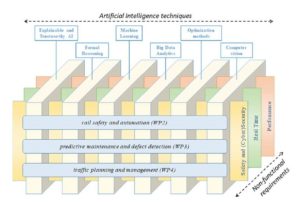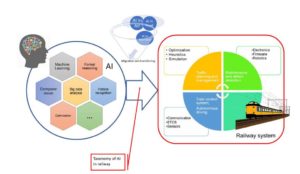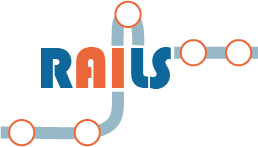RAILS (Roadmaps for A.I. Integration in the Rail Sector) is a three-year project funded by the Shift2Rail Joint Undertaking. The overall objective of the RAILS research project is to investigate the potential of Artificial Intelligence (A.I.) approaches in the rail sector and contribute to the definition of roadmaps for future research in next generation signalling systems, operational intelligence, and network management.
RAILS will address the training of PhD students to support the research capacity in A.I. within the rail sector across Europe by involving research institutions in four different countries with a combined background in both computer science and transportation systems.
RAILS will produce knowledge, groundbreaking research and experimental proof-of-concepts for the adoption of A.I. in rail automation, predictive maintenance and defect detection, traffic planning and capacity optimization. To that aim, RAILS will combine A.I. paradigms with the Internet of Things, in order to leverage on the big amount of data generated by smart sensors and applications.
The research activities will be conducted in continuity with ongoing research in railways, but the methodological and technological concepts developed in RAILS are expected to stimulate further innovation providing new research directions to improve reliability, maintainability, safety, security, and performance.
With respect to safety, emerging threats and certification issues will be addressed when adopting A.I. in autonomous and cooperative driving, based on the concepts of “explainable A.I.” and “Trustworthy AI”. With respect to cyber-physical threat detection, innovative approaches will be developed based on A.I. models like Artificial Neural Networks and Bayesian Networks together with multi-sensor data fusion and artificial vision.
Resilience and optimization techniques based on genetic algorithms and self-healing will be addressed to face failures and service disruptions as well as to increase efficiency and line capacity. All those techniques will pave the way to the development of the new “Railway 4.0”.

Figure: The scope of RAILS
Uniqueness
The railway is an area where the increase of performance and safety in the near future will deeply depend on the ability to derive insight from complex data sets and use that information for
monitoring, controlling and taking optimal decisions both beforehand and in real time.
AI technologies have the potential to streamline operational performance by increasing the level of effectiveness in decision-making and improving overall efficiency. For rail, this seems like an opportunity deserving a further expansion, even if it demands a deep culture change. Indeed, in the railway environment nowadays multiple sources generate or collect a huge amount of data in a variety of formats, whose size and complexity is beyond human ability to be thoroughly processed, and hence demand the adoption of AI tools for automated reasoning.
The uniqueness of RAILS is that it will provide a platform to explore the aforementioned integration of AI and railway in a holistic, unified and consistent framework, considering various
dimensions and facets of the railway system as interrelated, rather than isolated. The leading applications where AI is showing its potential in high-tech sectors, such as aerospace, automotive and robotics, are autonomous driving and smart maintenance.
Innovation potential
The current state-of-the-art in applying AI in railways shows that, although showing a huge potential, AI applications to railways are still fragmented and oriented to specific areas. It is clear that to reap all benefits AI presents, the rail industry and operators must tackle sector-specific challenges as well as common challenges shared with other transport sectors. For instance, train automation and autonomous driving would likely benefit from integrating technologies which are being researched and developed in the automotive industry for self-driving cars. Challenges that railways will share with automotive and other high-tech sectors concern funding digital and AI research, innovation activities, infrastructure as well as new digital technologies. Furthermore, given the wide range of operating conditions, operational scenarios and AI-driven tools for monitoring, predicting and controlling the railway systems, as well as their infrastructures, it is necessary to focus on the most promising AI solutions by considering the railway system in a holistic view.
Within this context, the main ambition of RAILS is to understand and identify which approaches within the broad area of AI can have a meaningful impact on railway systems, with possible
migration and technology transfer from other transport sectors and other relevant industries where the application of AI has proven to be feasible and advantageous. Along this direction, the
integration of the skills of project partners aims at providing integrated monitoring, detection, control and supervision platforms to support stakeholders involved in railway management. The
major innovation and value proposition of RAILS is illustrated in the following Figure.

It is important to highlight that one important activity performed within RAILS is the analysis of all S2R projects related to AI in terms of current progress and expected results, in order to leverage on synergies and fill any gaps on a longer time horizon (5+ years) for the definition of credible AI roadmaps in railways.
The final objective of RAILS will be the integration with the European policy to create a unique vision for a European Railway system, where AI will contribute to harmonization and integration of the different operational approaches and technical capabilities of the EU Member States. AI, as an arising and promising disruptive approach to railways, will be the key concept that challenges the traditional approaches and processes dominating the railway systems in the past, which have now started to show their limitations in the era of big data and digitalization.
